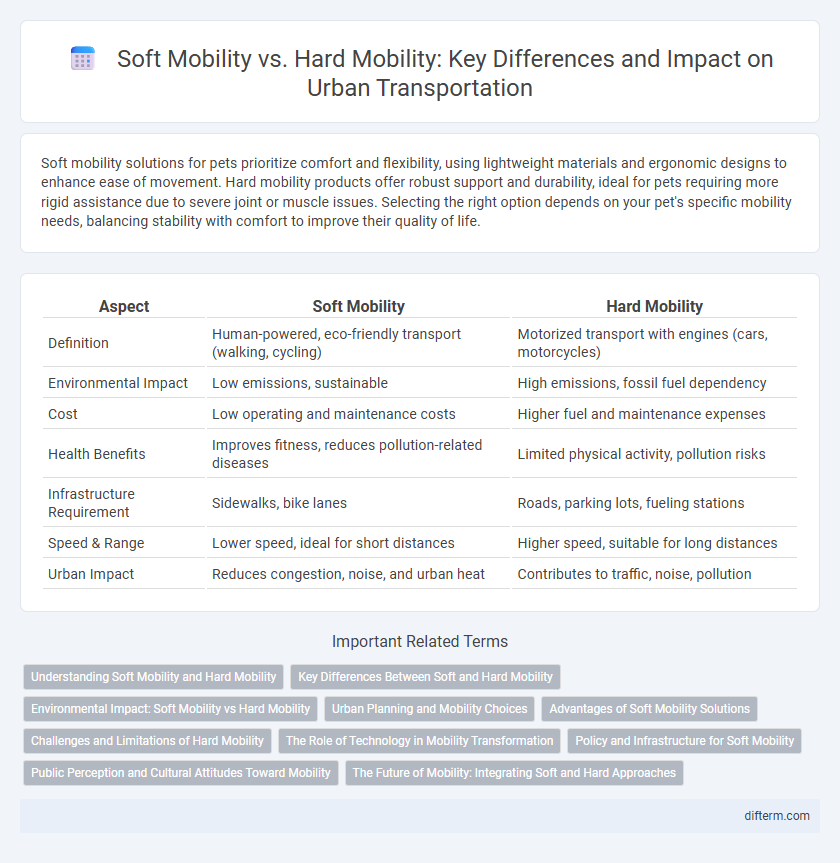Soft mobility solutions for pets prioritize comfort and flexibility, using lightweight materials and ergonomic designs to enhance ease of movement. Hard mobility products offer robust support and durability, ideal for pets requiring more rigid assistance due to severe joint or muscle issues. Selecting the right option depends on your pet's specific mobility needs, balancing stability with comfort to improve their quality of life.
Table of Comparison
| Aspect | Soft Mobility | Hard Mobility |
|---|---|---|
| Definition | Human-powered, eco-friendly transport (walking, cycling) | Motorized transport with engines (cars, motorcycles) |
| Environmental Impact | Low emissions, sustainable | High emissions, fossil fuel dependency |
| Cost | Low operating and maintenance costs | Higher fuel and maintenance expenses |
| Health Benefits | Improves fitness, reduces pollution-related diseases | Limited physical activity, pollution risks |
| Infrastructure Requirement | Sidewalks, bike lanes | Roads, parking lots, fueling stations |
| Speed & Range | Lower speed, ideal for short distances | Higher speed, suitable for long distances |
| Urban Impact | Reduces congestion, noise, and urban heat | Contributes to traffic, noise, pollution |
Understanding Soft Mobility and Hard Mobility
Soft mobility encompasses sustainable, low-impact transportation methods such as walking, cycling, and electric scooters, which prioritize environmental benefits and health improvements. Hard mobility involves conventional motorized transport modes like cars, buses, and trains, emphasizing speed, capacity, and infrastructure demands. Understanding the balance between soft and hard mobility is essential for urban planners to design efficient, eco-friendly, and inclusive transportation systems.
Key Differences Between Soft and Hard Mobility
Soft mobility primarily involves non-motorized transportation modes like walking, cycling, and skateboarding, emphasizing environmental sustainability and health benefits. Hard mobility refers to motorized vehicles such as cars, motorcycles, and buses, focusing on higher speed, longer distances, and infrastructure requirements. Key differences include energy consumption, environmental impact, infrastructure needs, and user accessibility.
Environmental Impact: Soft Mobility vs Hard Mobility
Soft mobility, including walking and cycling, significantly reduces carbon emissions and urban pollution compared to hard mobility modes such as cars and motorcycles, which are major contributors to air pollution and greenhouse gases. Electric vehicles offer improvements but still depend on energy sources and resource-intensive production, unlike zero-emission soft mobility options. Prioritizing infrastructure for soft mobility supports sustainable urban environments by minimizing noise pollution, lowering fossil fuel dependency, and promoting healthier ecosystems.
Urban Planning and Mobility Choices
Soft mobility prioritizes pedestrian, cycling, and public transport infrastructure within urban planning to reduce carbon emissions and enhance community health. Integrating green corridors and dedicated bike lanes encourages residents to shift from hard mobility options like private cars and motorbikes, decreasing traffic congestion and pollution. Strategic urban design that promotes accessible, safe, and interconnected pathways directly influences sustainable mobility choices and fosters resilient cities.
Advantages of Soft Mobility Solutions
Soft mobility solutions, such as walking, cycling, and the use of e-scooters, offer significant environmental benefits by reducing greenhouse gas emissions and decreasing air pollution compared to traditional hard mobility methods like cars and buses. These modes improve public health through increased physical activity and lower noise pollution, creating more livable urban spaces. Furthermore, soft mobility solutions often require less infrastructure investment, enabling cost-effective and flexible transportation options in densely populated areas.
Challenges and Limitations of Hard Mobility
Hard mobility faces significant challenges including high infrastructure costs, environmental impact, and limited accessibility in urban areas. Rigid transportation systems often struggle with traffic congestion, pollution, and energy inefficiency, contributing to unsustainable urban growth. These limitations prompt a growing shift towards integrating soft mobility solutions like walking and cycling to enhance sustainability and reduce ecological footprints.
The Role of Technology in Mobility Transformation
Technology is driving the transformation of mobility by enhancing both soft mobility options like walking and cycling through smart infrastructure and real-time data analytics, and hard mobility modes including autonomous vehicles and electrified public transit systems. Advanced sensors, IoT connectivity, and AI algorithms optimize traffic flow, improve safety, and reduce environmental impact across mobility ecosystems. Integration of mobile apps and digital platforms enables seamless multimodal journeys, fostering sustainable urban mobility while reducing dependence on traditional fossil-fuel vehicles.
Policy and Infrastructure for Soft Mobility
Soft mobility policies prioritize pedestrian-friendly infrastructure, extensive cycling networks, and safe public spaces to encourage active transportation modes like walking and biking. Urban planning integrates dedicated bike lanes, traffic calming measures, and ample green zones to enhance accessibility while reducing carbon emissions and traffic congestion. Investments in soft mobility infrastructure align with sustainable development goals by promoting health, reducing reliance on fossil fuels, and increasing urban livability.
Public Perception and Cultural Attitudes Toward Mobility
Public perception of soft mobility, including walking and cycling, often emphasizes environmental benefits, health improvements, and urban livability, driving increased acceptance in many cities. In contrast, hard mobility methods like private cars and motorbikes are culturally associated with status, convenience, and freedom, which sustains their dominance despite sustainability concerns. Cultural attitudes deeply influence mobility choices, where societies valuing green spaces and community interaction show stronger support for soft mobility infrastructure and policies.
The Future of Mobility: Integrating Soft and Hard Approaches
The future of mobility hinges on integrating soft mobility solutions, such as walking, cycling, and electric scooters, with hard mobility infrastructure like electric vehicles and smart transit systems, fostering a seamless, sustainable transportation ecosystem. Urban planners prioritize mixed-use developments and dedicated bike lanes alongside advanced public transit networks to reduce carbon emissions and traffic congestion. Emerging technologies like IoT and AI optimize mobility management, enabling real-time data-driven decisions that balance efficient movement with environmental consciousness.
soft mobility vs hard mobility Infographic

 difterm.com
difterm.com